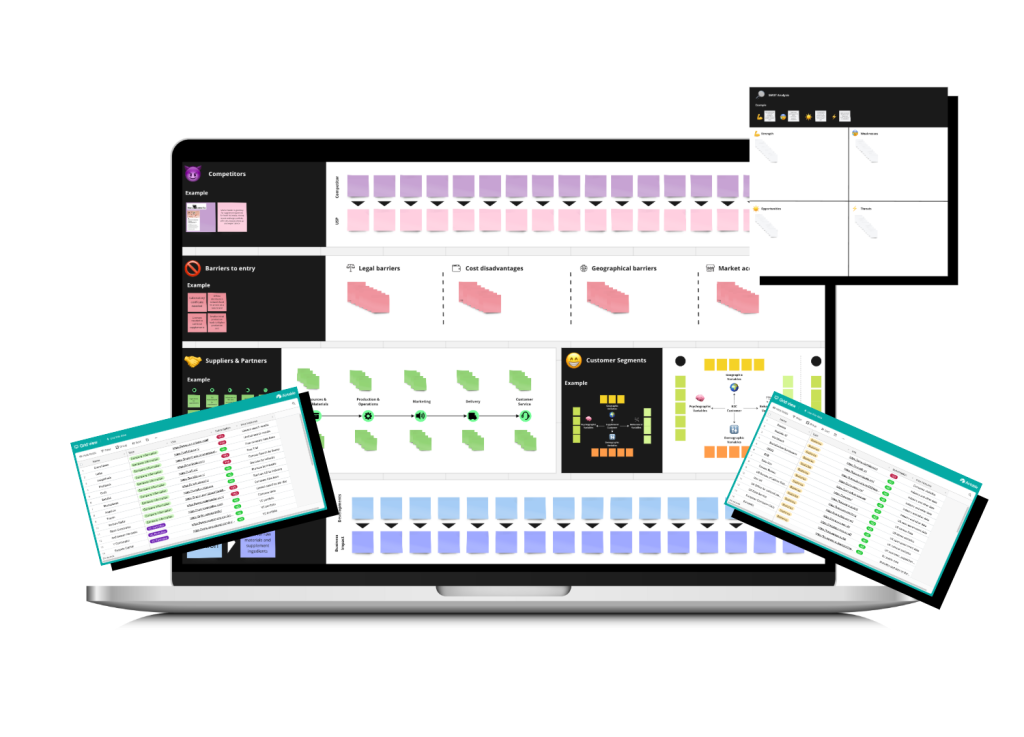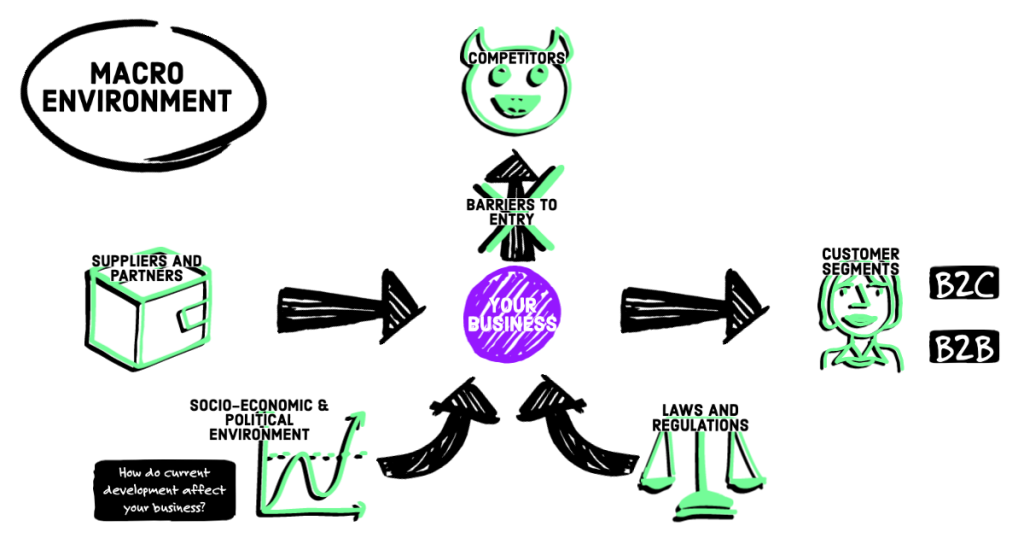Understanding your Market Environment is crucial for achieving startup success. A Market Environment Analysis is a methodical approach that helps in comprehending external factors that could influence business operations. Let’s delve into why this analysis holds such significance and how it can benefit startup founders.
💡 What is Market Environment Analysis?
Market Environment Analysis is a systematic breakdown of external elements affecting a business. It involves assessing customer segments, competitors, entry barriers, suppliers, socio-economic and political factors, and a SWOT analysis. This process enables startups to grasp the dynamics shaping their operational landscape.
🚀 Why is a Proper Market Environment Analysis Important?
A thorough market environment analysis is crucial when building a new business or developing new offerings. It will help you to:
- Make Informed Decisions: Understanding market dynamics assists in making strategic decisions based on real-world insights.
- Identify Business Opportunities: Analysis reveals untapped market segments and potential areas for growth.
- Mitigate Risks: Recognizing threats allows proactive measures to minimize risks and uncertainties.
- Easier Strategic Planning: Helps in devising business strategies aligned with market trends and demands.
- Optimize Resources: Enables efficient allocation of resources by focusing on key market areas.
🗒️ Market Environment Analysis Step-by-Step
Mastering this approach to Market Environment Analysis is a fundamental determinant for startup triumph because it equips you with a comprehensive and strategic report, outlining the key market factors which you should take into account in your business building or innovation process.
✅ Step A: Understand your Customer Segments
- Precisely Define Target Customer Segments: Begin by categorizing potential customers into B2B or B2C categories. Utilize a mix of demographic parameters such as age, gender, income level, and geographic data to understand their preferences and needs. Behavioral factors like shopping habits, decision-making processes, and psychographic insights such as lifestyle and interests must also be considered.

- Segmentation Variables for B2C Customers: For B2C segments, segment customers based on geographic variables (region, country, urban/rural areas), demographics (age, gender, income), behavior (shopping channels, frequency), and psychographics (lifestyle, interests, values). Assessing these variables will help craft specific strategies aligned with diverse customer needs.
- Segmentation Variables for B2B Customers: When targeting B2B clients, focus on geographic variables, firmographics (company size, revenues, industry/sector), behavioral elements (shopping channels, frequency, decision-making), and psychographics (working style, company culture, values). Understanding these aspects aids in tailoring products/services to meet business client requirements effectively.
✅ Step B: Analyze your Competitors
- Comprehensive Competitor Research: Conduct exhaustive research using various resources like company databases, VC portfolios, keyword analysis tools, and thorough Google searches to identify direct and indirect competitors. Ensure they operate within the same market and offer similar products or services.
- Identifying Competitive Advantages: Once competitors are identified, delve deeper into their strengths and weaknesses. Analyze what sets them apart (Unique Selling Proposition – USP), their market position, customer base, and marketing strategies. This insight helps in positioning the startup effectively within the competitive landscape.
✅ Step C: Assess Potential Obstacles and Entry Barriers
- Legal Hurdles: Investigate specific laws and regulations affecting your products/services in targeted countries. Identify whether special licenses or permissions are required to operate within those markets.
- Cost Disadvantages: Recognize if existing competitors enjoy cost advantages due to economies of scale or better supplier terms, and strategize accordingly.
- Geographical Considerations: Evaluate country-specific barriers, language barriers, and the need for special permits when expanding beyond native markets.
- Market Access: Understand the ease of gaining access to suppliers or distributors. Recognize any disadvantages compared to established competitors.
- Switching Costs: Assess customer loyalty to existing brands and the difficulty/cost involved in switching to a new provider. This insight helps in developing customer retention strategies.
✅ Step D: Map Suppliers and Partners throughout the value chain
- Resource Sourcing: Identify potential partners involved in the sourcing of necessary resources or raw materials required for products or services.
- Production & Operations: Evaluate the necessity of partnering with external entities for production or service delivery and their availability.
- Marketing Channels: Assess whether and which partnerships are needed for marketing.
- Delivery Mechanisms: Assess potential logistic and sales partners, which are available in your market.
- Customer Service: Outline how customer service will be provided. and evaluate the possibility of outsourcing this service to partners.
✅ Step E: Understanding the Socio-Economic and Political Environment
- Economic Analysis: Investigate global economic conditions and potential impacts on the business. Utilize resources from IMF, World Bank, and other relevant sources to forecast economic trends.
- Political Scenarios: Analyze political developments and their potential business impacts. Assess the stability of the business environment and any legal changes that might affect operations.
✅ Step F: Summarize your Findings into a SWOT Analysis
- Strengths: Highlight the areas where the business excels and holds a competitive advantage.
- Weaknesses: Identify aspects where the business lags or faces challenges compared to competitors.
- Opportunities: Discover new possibilities and unexplored markets or segments.
- Threats: Recognize external factors that could pose risks or challenges to the business.
In conclusion, understanding and analyzing the market environment through these systematic steps are critical for startups. It lays the groundwork for informed decision-making, risk mitigation, and efficient resource allocation, providing a significant edge in the competitive landscape.

Get Ready-to-Use Templates and Practical Guidances . 🚀
Check out our basecamp for founders for practical guidance and templates on Market Environment Analysis and many more business building methodologies.

